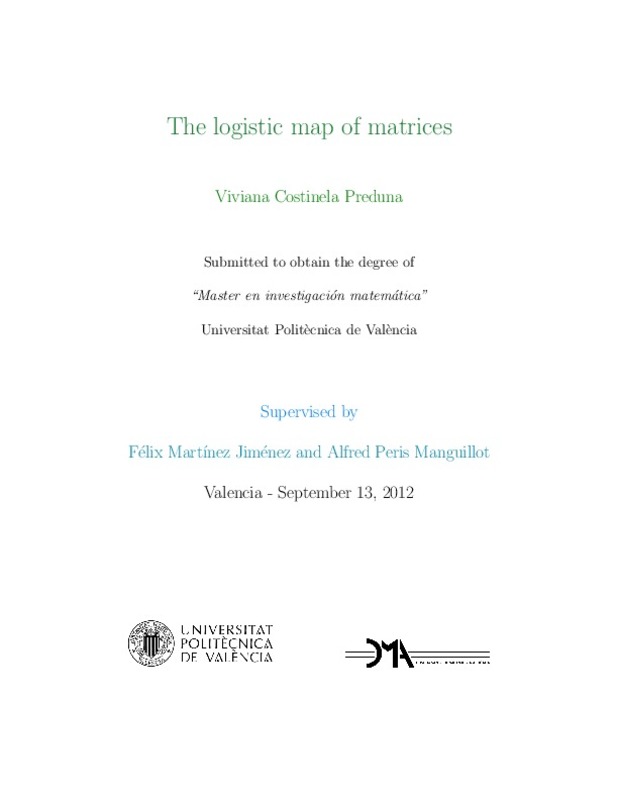JavaScript is disabled for your browser. Some features of this site may not work without it.
Buscar en RiuNet
Listar
Mi cuenta
Estadísticas
Ayuda RiuNet
Admin. UPV
The logistic map of matrices
Mostrar el registro sencillo del ítem
Ficheros en el ítem
| dc.contributor.advisor | Martínez Jiménez, Félix
|
es_ES |
| dc.contributor.advisor | Peris Manguillot, Alfredo
|
es_ES |
| dc.contributor.author | Preduna, Viviana Costinela
|
es_ES |
| dc.date.accessioned | 2013-02-27T13:35:43Z | |
| dc.date.available | 2013-02-27T13:35:43Z | |
| dc.date.created | 2012-09-14 | |
| dc.date.issued | 2013-02-27 | |
| dc.identifier.uri | http://hdl.handle.net/10251/27378 | |
| dc.description.abstract | [ES] La dinámica de la familia logística clásica cuando se reemplaza el el escalar por una matriz | es_ES |
| dc.description.abstract | [EN] The main goal of this work is to show what happens when instead of the logistic map with a scalar we use a matrix. This work is based on a paper of 2011 from a investigation team of Lithuania[1]. The logistic map is a polynomial mapping (equivalently, recurrence relation) of de- gree 2, often cited as an archetypal example of how complex, chaotic behaviour can arise from very simple non-linear dynamical equations. The map was popularized in a seminal 1976 paper by the biologist Robert May, in part as a discrete-time demographic model analogous to the logistic equation rst created by Pierre Fran cois Verhulst. The logistic map is one of the most simple forms of a chaotic process. Basically, this map, like any one-dimensional map, is a rule for getting a number from a number. The parameter a is xed, but if one studies the dynamics of the the map for di erent values of a, it is found that this parameter is the catalyst to show a variety of possibilities (including chaos). Dynamical properties of the iterative map are explored in detail when the order of matrices is 2. We will see that the evolution of the logistic map depends not only on the control parameter but also on the eigenvalues of the matrix of initial conditions. The second part is reserved for computational examples that are used to demonstrate the convergence to periodic attractors and the sensitivity of chaotic processes to initials conditions. In the rst chapter we are going to do a short introduction about the well-known logistic map with a scalar variable and a several properties of square matrices of order 2. We will see the algebraic representation of matrices and some properties of the matrix with a few corollaries. The second chapter will include the dynamic of the logistic map with matrices and parametric expressions of idempotent and nilpotent ma- trix. The second part of this chapter will contain theorems and results about the dynamics of the logistic map of matrices, such as the theo- rem of bounded four iterated sequences in the case of idempotents and nilpotent matrices. In the third chapter we illustrate the behavior of iterated matri- ces of order 2 with some computational experiments. We will to see how the nilpotent and idempotent matrix react by changing the initial conditions and the parameter a and the attractors in every case are the key point for beginning the study of these experiments. The last part of the third chapter will be the concluding remarks like advan- tages, disadvantages and a short comparator with the scalar form of the iterative logistic map. | es_ES |
| dc.format.extent | 39 | es_ES |
| dc.language | Inglés | es_ES |
| dc.publisher | Universitat Politècnica de València | es_ES |
| dc.rights | Reconocimiento - No comercial - Sin obra derivada (by-nc-nd) | es_ES |
| dc.subject | Familia logística | es_ES |
| dc.subject | Caos | es_ES |
| dc.subject | Matrices | es_ES |
| dc.subject | Logistic map | es_ES |
| dc.subject | Chaos | es_ES |
| dc.subject.other | Máster Universitario en Investigación Matemática-Màster Universitari en Investigació Matemàtica | es_ES |
| dc.title | The logistic map of matrices | es_ES |
| dc.type | Tesis de máster | es_ES |
| dc.rights.accessRights | Abierto | es_ES |
| dc.contributor.affiliation | Universitat Politècnica de València. Servicio de Alumnado - Servei d'Alumnat | es_ES |
| dc.description.bibliographicCitation | Preduna, VC. (2012). The logistic map of matrices. http://hdl.handle.net/10251/27378 | es_ES |
| dc.description.accrualMethod | Archivo delegado | es_ES |






